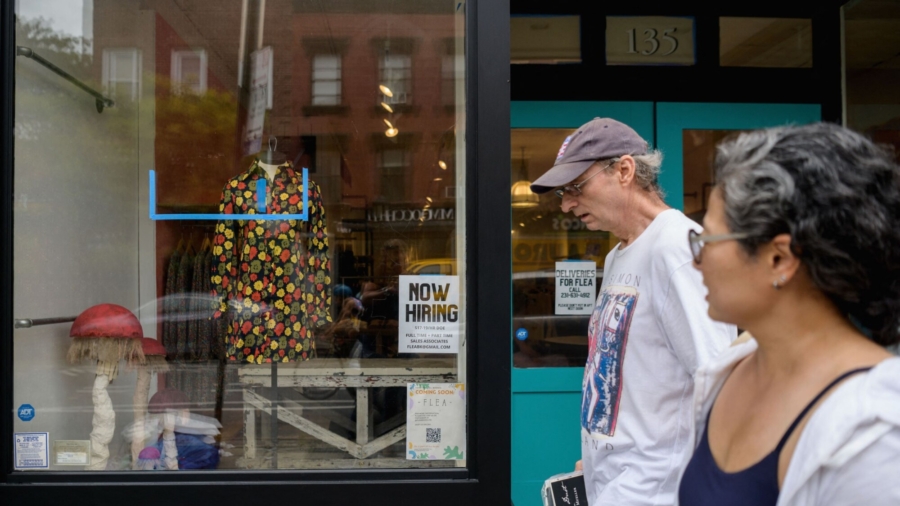Another 340,000 American workers filed for unemployment last week, a historically elevated number that nonetheless marked the lowest weekly level of jobless claims since the pandemic struck.
First-time filings for unemployment insurance, a proxy for layoffs, came in at 340,000 for the week ending Sept. 2, a drop of 14,000 from the previous week’s revised level of 354,000, the Labor Department said in a statement (pdf). This is the lowest weekly claims figure since March 14, 2020, when 256,000 people filed for unemployment.
Continuing claims, which represent the number of people collecting unemployment benefits after earlier filing an initial claim, fell by 160,000 to 2.7 million, also the lowest level since March of last year.
“After a series of negative surprises with economic data, new pandemic era lows for both new and continuing jobless claims are welcomed developments,” Bankrate senior economic analyst Mark Hamrick told The Epoch Times in an emailed statement. “There’s still a way to go to get back into the low-to-mid 200,000 range where new claims stood before the pandemic exploded and took a massive toll on the U.S. economy.”
Lockdowns and other restrictions imposed in the face of the outbreak pushed weekly claims to a record high of 6.2 million in April 2020. Jobless filings have mostly fallen steadily since then, though they’ve been stuck in the mid-to-high 300,000 range since June. Prior to the pandemic, weekly claims averaged around 220,000.
The Labor Department’s jobless claims report also showed that nearly 12.2 million Americans were receiving some form of unemployment assistance in the week ending Aug. 14, an over-the-week increase of nearly 180,000 and evidence that the labor market recovery still has a ways to go. The U.S. economy remains around 5.7 million jobs down compared to the February 2020 peak.
Meanwhile, looming large is Friday’s so-called nonfarm payrolls data, with the closely watched jobs report setting the stage for deliberations around labor market health at the Federal Reserve’s policy meeting later in the month. Continued labor market recovery is upping pressure on Fed officials to begin withdrawing some of the crisis support measures for the economy.
“Now, the August employment report is anxiously awaited,” Hamrick said. “At issue is whether, or how much, the surge in COVID cases has dampened hiring. Other headwinds include inflation spurred by global supply chain disruptions and the mismatch between available workers and open positions.”
American employers posted a record 10.1 million job openings in June, the latest month of available figures. Workers have been buoyed by the record-high number of job vacancies, boosting their bargaining power and forcing businesses to raise wages. The so-called quits rate, which is the proportion of people who voluntarily leave their jobs and is a barometer of worker confidence in being able to find a better job elsewhere, was 2.7 in June, the month for which the latest figures are available, only slightly lower than April’s record high of 2.8.
“This continues the perplexing paradox of companies reporting record ‘labor shortages’–companies reporting inability to find workers, while workers continue to report inability to find jobs at a rate 50 percent higher than before the 2020 lockdowns,” said John Rosen, a professor at the Pompea College of Business, University of New Haven, in an emailed statement to The Epoch Times.
Federal Reserve chair Jerome Powell last week struck a largely dovish tone at the annual economic symposium in Jackson Hole, Wyoming, saying the central bank would continue buying bonds at the current pace until “we see substantial further progress” towards the Fed’s dual goals of price stability and maximum employment.
Powell acknowledged a sharp run-up in inflation but argued that it would be transitory, while noting incoming data showing upwards price pressures were starting to moderate. He said that the “substantial further progress” test had been met for inflation and that there had been “clear progress” towards the maximum employment objective but struck a cautionary tone around labor market recovery in the face of the spread of the Delta variant of the CCP (Chinese Communist Party) virus.
“The intervening month has brought more progress in the form of a strong employment report for July, but also the further spread of the Delta variant. We will be carefully assessing incoming data and the evolving risks. Even after our asset purchases end, our elevated holdings of longer-term securities will continue to support accommodative financial conditions,” Powell said.
In response to the pandemic recession, the Fed dropped its benchmark interest rate to near zero and set out on a massive asset-buying program, purchasing some $120 billion in monthly Treasury and mortgage securities. Powell said in Jackson Hole that the Fed could start reducing the pace of asset purchases this year.
From The Epoch Times


